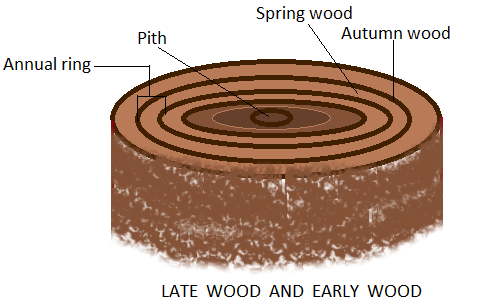
Answer
438.3k+ views
Hint:The vascular cambium tissue which is present between the xylem and phloem of plants causes secondary growth. Secondary growth of xylem results in the formation of springwood and autumn wood. Springwood is produced inwardly and has lighter wide circles. Autumn wood lies outer to springwood and has dark narrow circles.
Complete answer:
The secondary growth in the xylem forms the springwood and autumn wood which further forms cambium rings. The cambium rings can be used to calculate the age of the tree. This concentric ring formation is influenced by climatic changes. During the spring season, the cambium becomes more active and forms a large number of xylem vessels having wider cavities. This is known as springwood. It has more number of xylary elements with wider vessels. It is also known as earlywood.

In the winter season, the cambial activity reduces or slows down. This gives rise to narrow xylem elements. The wood formed during this period is called autumn wood or latewood. It contributes to the narrow darker stripes or circles. Autumn wood is found at the end of an annual ring. The annual ring is formed by springwood. The autumn wood has fewer xylary elements with narrow vessels. It is denser as compared to springwood.
Thus, we can conclude that option D) is the right answer.
Note: The springwood is wider and lighter due to an abundant supply of nutrients from the soil. On the other hand, in the winter season, the nutrient availability becomes scarce and autumn wood is produced in thinner bands. Wood is sometimes also referred to as secondary xylem. It majorly consists of carbon, oxygen, nitrogen, and hydrogen.
Complete answer:
The secondary growth in the xylem forms the springwood and autumn wood which further forms cambium rings. The cambium rings can be used to calculate the age of the tree. This concentric ring formation is influenced by climatic changes. During the spring season, the cambium becomes more active and forms a large number of xylem vessels having wider cavities. This is known as springwood. It has more number of xylary elements with wider vessels. It is also known as earlywood.

In the winter season, the cambial activity reduces or slows down. This gives rise to narrow xylem elements. The wood formed during this period is called autumn wood or latewood. It contributes to the narrow darker stripes or circles. Autumn wood is found at the end of an annual ring. The annual ring is formed by springwood. The autumn wood has fewer xylary elements with narrow vessels. It is denser as compared to springwood.
Thus, we can conclude that option D) is the right answer.
Note: The springwood is wider and lighter due to an abundant supply of nutrients from the soil. On the other hand, in the winter season, the nutrient availability becomes scarce and autumn wood is produced in thinner bands. Wood is sometimes also referred to as secondary xylem. It majorly consists of carbon, oxygen, nitrogen, and hydrogen.
Recently Updated Pages
Write the IUPAC name of the given compound class 11 chemistry CBSE

Write the IUPAC name of the given compound class 11 chemistry CBSE

Write the IUPAC name of the given compound class 11 chemistry CBSE

Write the IUPAC name of the given compound class 11 chemistry CBSE

Write the IUPAC name of the given compound class 11 chemistry CBSE

Write the IUPAC name of the given compound class 11 chemistry CBSE

Trending doubts
Fill the blanks with the suitable prepositions 1 The class 9 english CBSE

How do you graph the function fx 4x class 9 maths CBSE

Which are the Top 10 Largest Countries of the World?

Which is the longest day and shortest night in the class 11 sst CBSE

What is the definite integral of zero a constant b class 12 maths CBSE

Name five important trees found in the tropical evergreen class 10 social studies CBSE

The Equation xxx + 2 is Satisfied when x is Equal to Class 10 Maths

Differentiate between homogeneous and heterogeneous class 12 chemistry CBSE

Difference between Prokaryotic cell and Eukaryotic class 11 biology CBSE




